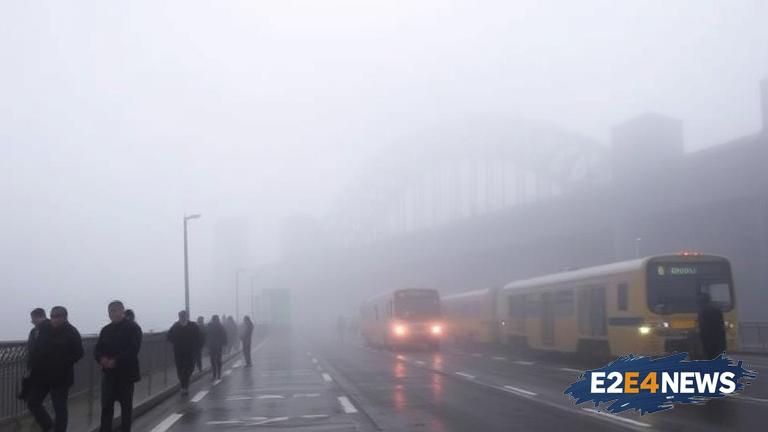A thick fog has descended upon Sydney, bringing with it a slew of disruptions to commuters and flights. The fog, which rolled in overnight, has reduced visibility to just 100 meters in some areas, making it difficult for people to navigate the city. The Sydney Harbour Bridge and Opera House were shrouded in a thick mist, with only the outlines of the iconic landmarks visible. Commuters were faced with lengthy delays, with many trains and buses running behind schedule. Flights in and out of Sydney Airport were also affected, with some flights cancelled or delayed due to the poor visibility. The fog was so thick that it was difficult for drivers to see more than a few meters in front of them, leading to a significant increase in travel times. The New South Wales transport authority warned commuters to expect delays and to plan their journeys accordingly. The fog was caused by a combination of cool air and moisture, which created a thick layer of fog that blanketed the city. The Bureau of Meteorology issued a fog warning for the Sydney area, warning of reduced visibility and hazardous driving conditions. The fog was expected to clear by mid-morning, but not before causing chaos for commuters. Many people took to social media to express their frustration at the disruptions, with some calling for better warning systems to be put in place. The fog also caused problems for emergency services, with paramedics and firefighters facing difficulties in responding to calls. Despite the challenges, many Sydneysiders took to social media to share photos and videos of the fog, with some even describing it as ‘magical’. The fog was a rare occurrence in Sydney, with the city typically experiencing a mild climate. However, the fog was a reminder of the unpredictable nature of the weather, and the importance of being prepared for any eventuality. The city’s transport system was put to the test, with many commuters forced to find alternative routes or modes of transport. The disruptions were not limited to the city, with surrounding suburbs also affected by the fog. The fog also had an impact on local businesses, with some forced to close or reduce their hours due to the poor visibility. As the fog began to clear, commuters were left to deal with the aftermath, with many facing lengthy delays and disruptions. The incident highlighted the need for better infrastructure and planning to deal with unexpected weather events. In the end, the fog may have caused chaos, but it also brought the city together, with many people coming out to share in the experience. The city’s residents were reminded of the importance of community and resilience in the face of adversity. As the city returned to normal, many were left to wonder when the next unexpected weather event would occur, and how they would respond.





